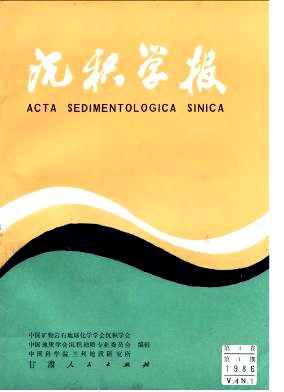THE MIGRATION FORM AND CONCENTRATION MECHANISM OF LEAD-ZINC IN HYDROTHEMAL SOLUTION OF LOW-TEMPERATURE
- Received Date: 1984-07-30
- Publish Date: 1986-03-10
Abstract: Features of the mode and occurrence of ore bodies, the mineral assemblages and the texture and structure of ores in bed-bound Pb-Zn sulphide deposits are characterized by the syngenetic deposition diagenetic miner-algenesis and obvious remoulding of double thermal solution. In order to examine the possible migration forms and the concentration mechanism of lead and zinc during hydrothemal mineralization, we have made studies on the composition of mineral inclusion. of spholerite and calcite the sulful isotope of galena and sphalerite and the thermodynamic-condition analysis of mineralization. On this basis, the solubility of galena and sphalerite are determined in the NaCl-solution containing organic matters ( for example, α-Lam, H3Cit, etc.) or NH4OH, at 90℃. The phalerite solublity in NaCl-solution containing organic matters or NH4OH has come up to the minimum metal concentration of mineralization (about n×10-5M), and it increases with the rise of concentration and temperature of ligand in the solution. A maximun solubility ( about 25× 10-5M) is found in α-Lam H3C-it solution at 90℃. In addition, on the basis of the simultaneous equilibrium theory of hydrothermal system,the accumulative stable constants of diffrent zinc-lead in organic and organic complexes at different temperature ( 30°, 50°, 70°, 90°) and different ionic strength ( I= 0.1, 0.5), are determined within the ranges of 1 atm and the pH 4-8 by using the electrone potential method. This paper deals with the remobilization of leadzinc sulphide in source beds, its factors controlling its limit,the migration form, stability and distribution of lead and zinc in the low-temperature hyorothemal solution, the reproduction of sphalerite, the crystalline deposit of galena and the deposit mechanism of galena and sphalerite. Our study shows that the ability of remobilization and migration is linear with the Fronaenus function φ and the Ledan function ψ. Its limit is controlled by the kind and temperature of ligand ion in solution and the thermodynamic conditions of environment, such as T, Eh, and pH. In the Me-Cl-H2O thermal saline water of low-temperature, the migration form of zinc is mainly Zn2+ when Log Cl- is -2. With the increase of T and (Cl-), Zn2+ is replaced by ZnCln2-n. ZnCl32-. and ZnCl31- is preponderant in high salinewa- ter. Pb2+prevails only at T100℃ and Log(Cl-)-2 . 5 . PbCl24 is preferred in all other conditions. On the basis of our study and analysis, we have pointed out that the mineralization solution is mainly the Na-Ca-Cl type of thermal brine water bearing nich orgahic matters. This kind of thermal brine water extracts metallogenetic elements from the source bed, and transports them to the favorable structural locations. Thus, they turn into lead-zinc sulfide deposits under the control of geochemical impediments.
| Citation: | Li Peilan, Leng Shengqiang. THE MIGRATION FORM AND CONCENTRATION MECHANISM OF LEAD-ZINC IN HYDROTHEMAL SOLUTION OF LOW-TEMPERATURE[J]. Acta Sedimentologica Sinica, 1986, 4(1): 64-76. |






 DownLoad:
DownLoad: